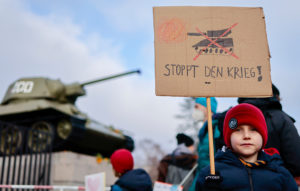The Berlin elite is quick to lambast other countries for any perceived lack of predictability. Being berechenbar or “reckonable” ranks high among the Teutonic virtues. So Germany’s own recent policy gyrations have been wondrous to behold.
The attack on Ukraine has rendered it desirable to condemn Putin, to call for an end to energy dependence on Russia, and urge shipments of arms to Kyiv. Nato has replaced the phantasms of EU-based defence. Ukraine is given a path, albeit lengthy, into the Union. Our bemusement rises as we recall how ragingly this departs from the iron-clad, cross-party consensus under Angela Merkel and her predecessors.
No U-turn has been more radical than the pledge to end decades of de facto pacifism, and to spend seriously on the armed forces. Self-congratulations reverberated in early June when Germany’s parliament agreed a one-off fund of €100 billion, ostensibly to bring the painfully under-resourced Bundeswehr up to scratch. Virtual unanimity ruled. Olaf Scholz’s governing coalition was joined by the opposition CDU-CSU. At home and abroad, the vote was hailed as evidence of new geopolitical maturity.
But that for now is nonsense. There’s been no time for the Berlin state machine to develop a new security doctrine and to sell this to the population. In an echo of other unGerman instant shifts — remember Merkel’s departure from nuclear power, and her opening of the borders? — the decision has preceded the thinking.
What Germany does with its military is clearly crucial: for allies, neighbours, Putin, and the world. So as we monitor the evolving policies, we’d do well to remember how brittle the overnight epiphany might be. The war itself is hardly berechenbar, the impact of Putin’s squeeze on gas isn’t predictable, and the German body politic is deeply split on matters of defence.
Symptomatic of the divisions is the coalition‘s internecine war over weapons for Ukraine. The Foreign (run by the Greens) and Finance (the FDP) Ministries have fought against Defence (run by the SLD). At the core of the chaos has been the Chancellor himself, pathologically opposed to sending vital panzers and other serious kit.
At the EU, G7, and Nato summits Scholz has again sworn to support Ukraine. His veracity has been undermined, however, by his chief foreign policy adviser, who blurted out that Germany’s main aim is to secure its future links with Russia. No surprise here, perhaps: the atavistic SLD apparat has long had a sadomasochistic fixation on Moscow. Scholz himself felt puppy love for Russia when senior in the SLD’s youth wing in the Eighties. He was a fanatical Marxist, rabidly pro-Soviet, and dead against democracy for Central Europe. He rose under chancellor Schröder, latterly legendary as a paid lobbyist for Putin. In this context a sally by Lars Klingbeil, head of the SLD, has raised eyebrows around the world. Germany must be a leading power, a Führungsmacht. The military implications were there but weren’t explained.
Which brings us to the Bundeswehr. The new fund is less than a third of the measly total spent by Germany on its military in the past six years. In 2014 all of Nato agreed a target of 2% of GDP on defence, but Germany brazenly refused to keep its word. It’s been spending around 1.3%. The target of 2% would have meant a total of around €520 billion; 3% would have equated to €780 billion. The US percentage has been around 3.5%. Sir Richard Shirreff, Deputy Supreme Commander of Nato in Europe in the mid-Merkel years, isn’t impressed. He tells me: “It’s likely that Putin would’ve been put off his adventures if the largest economies in Europe, Britain, France, but especially Germany, hadn’t freeloaded, and had invested properly in defence.”
In any case, we can’t be sure that the €100 billion will be spent sensibly. The numbers throw up many questions. €33 billion is to go on air systems such as 35 American F-35s, €21 billion on digital command and control, €17 billion on land capabilities, and €8 billion on vessels. But what about “sustainment” costs? In the US, initial outlays for F-35s are less than a quarter of forecast “through-life” costs, and similar arithmetic will apply to Germany’s other purchases. Modern military kit costs many times what you pay up front when operations and maintenance are factored in. So even if the shopping list makes sense in light of Ukraine, it’s pretty clear that in future Germany will have to spend close to 3% of GDP. But there’s no sign of support even for 2%, not from the Finance Ministry under the fiscally frigid FDP, nor from the pacifists in the SLD, or in the population at large.
Then take motivation and morale. The Bundeswehr has a mere 100,000 personnel or so in combat roles (total headcount is 183,000). Expansion will rely disproportionately on the eastern Länder, where unemployment is relatively high, but support for the extreme-right Alternative für Deutschland (AfD) is strong. This cannot be ignored: the military have been wracked by Right-wing penetration.
Worryingly, the Bundeswehr has itself been fostering distortions of the Nazi past. The extent of the disease was shown in a survey for the elite newspaper Die Zeit: half the population is convinced that the Nazis were a small group who captured their country, so most Germans were innocent of war and Holocaust (among supporters of the AfD, 84% think so). Meanwhile, 30% believe, insanely, that their relatives resisted. Around two-thirds believe the country was not defeated but liberated in 1945. Almost 60%, and over four-fifths of AfD supporters, hold that other countries are just as guilty as Germany for Nazi wars and crimes. As the Bundeswehr expands, this kind of thinking may be more rife than ever in its ranks.
So as we watch how Berlin rearms, we’d do well to monitor the narratives and doctrines it develops as closely as the technology it deploys. Nowhere will scepticism be greater than on the Nato and EU front line in Central Europe. There’s consternation there over Germany’s recasting of its history. There is existential worry, too, about Bundeswehr fulfilment of Article Five of the Nato treaty, under which each member is to fight if any is attacked. Before the Ukrainian war only 34% of Germans would have helped if Russia invaded the front-line states.
We don’t know if more (or fewer) would today. Whatever the number, what would it mean for the nascent Führungsmacht? In places like Warsaw and Prague many are already convinced that the whole German deep state, not just the SLD, is with Russia in wanting Ukraine to fail. This is because a successful Ukraine (plus Moldova and Georgia) would soon be in the EU. With Poland and others, they could form a pro-Atlantic block with one-third of the Union’s population, and so scupper Germany’s hegemonic plans. When Jarosław Kaczyński, head of the ruling party in Warsaw, wondered publicly the other day whether Germany is arming against Putin or Poland, he was making a joke. Not a very good one, perhaps, but one whose bitter core is clear.
Disclaimer
Some of the posts we share are controversial and we do not necessarily agree with them in the whole extend. Sometimes we agree with the content or part of it but we do not agree with the narration or language. Nevertheless we find them somehow interesting, valuable and/or informative or we share them, because we strongly believe in freedom of speech, free press and journalism. We strongly encourage you to have a critical approach to all the content, do your own research and analysis to build your own opinion.
We would be glad to have your feedback.
Source: UnHerd Read the original article here: https://unherd.com



